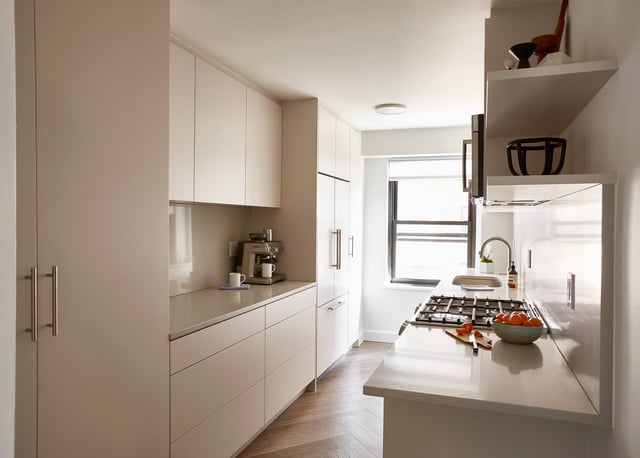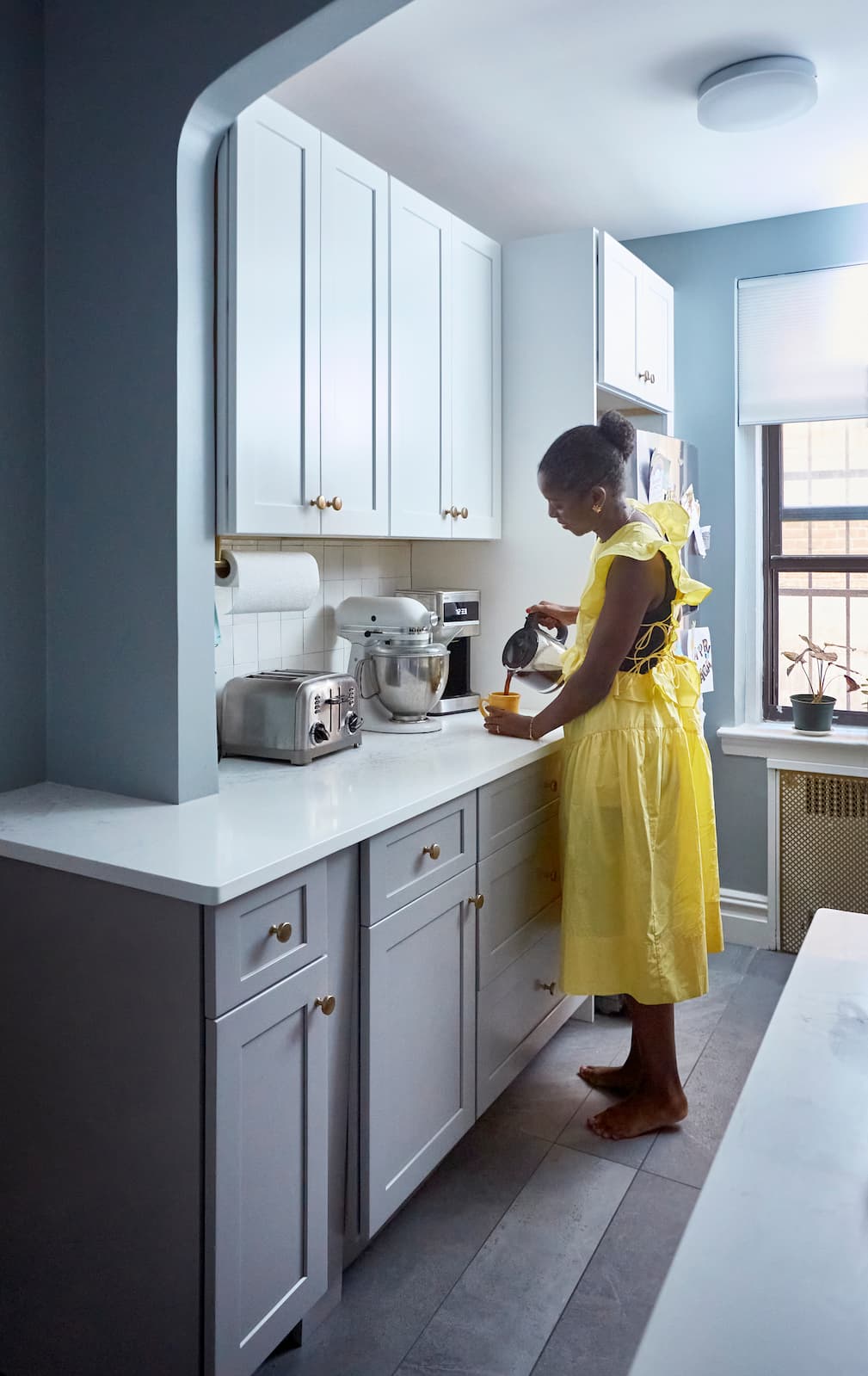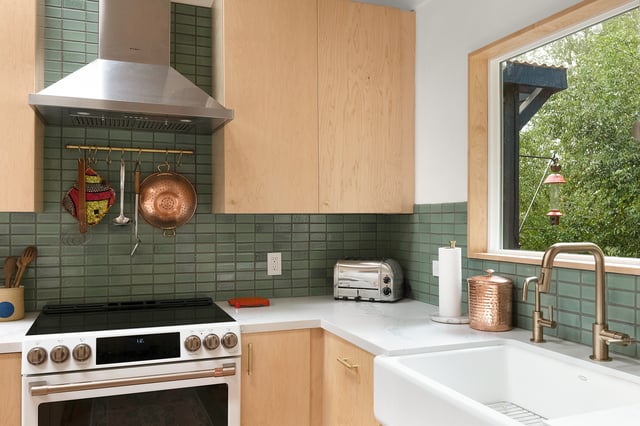
Finance
With Lower Interest Rates, Is Now a Good Time to Renovate?
09.18.2025

In This Article
Gut renovating in 2025 isn’t for the impulsive. It’s for the planner. The dreamer. The homeowner with a vision board full of possibility—and the grit to see it through. It’s a process that asks for patience and offers transformation in return.
Design a Home That’s Uniquely Yours
Block can help you achieve your renovation goals and bring your dream remodel to life with price assurance and expert support.
Get Started
This guide breaks it all down. Permits, timelines, design choices, and final walkthroughs. Step by step, so you’re never guessing what comes next. Because this isn’t just a renovation, it’s a chance to reimagine how you live and build a home that truly fits.
Think of it as a full reset. A blank canvas. You’re not just switching out tile or painting over beige—you’re taking everything back to the bones and building it all over again. Floors? Gone. Walls? Reworked. Systems hiding behind those walls? Updated, replaced, or rerouted entirely. It’s not a patch job. It’s a chance to create something new—something that finally feels like it fits.
A gut renovation means starting from scratch. You’re peeling everything back to the studs and rebuilding with purpose. That includes the visible layers—floors, ceilings, finishes—but also what’s behind the scenes: plumbing, electrical, and structural framing. In some cases, it even means rethinking the layout itself.
This isn’t about fixing what’s broken. It’s about reimagining what’s possible. Whether you’re addressing long-standing issues or reshaping how your home functions, gutting the space gives you the freedom to do it right, not just over.
Learn More: An Ultimate Guide to Gut Renovations in NYC
Not every home needs a full reset. Sometimes, a cosmetic update is enough—a fresh coat of paint, new hardware, better lighting. Those changes can lift a space visually without changing how it works.
But when the layout no longer makes sense, the systems are aging out, or you’re already opening up walls for another reason? That’s where gut renovation comes in. It’s not just deeper—it’s different. More complex, more involved, and yes, more rewarding.
Cosmetic upgrades give your home a facelift. A gut renovation gives it a new backbone.
A gut renovation is worth considering when surface updates alone won’t solve your biggest challenges. If your layout is inefficient, your plumbing or electrical systems are outdated, or you're already opening up walls for other repairs, starting fresh can make more sense than working around what’s already there. It’s especially worthwhile if you plan to stay long-term or restore an older home that hasn’t seen updates in decades.
Beyond resolving issues, gutting your space gives you full creative control, so you can design a home that looks the way you want and works the way you need.
Renovate with confidence every step of the way
Step 1: Personalize Your Renovation Plan
Step 2: Receive Quotes from Trusted Contractors
Step 3: Let Us Handle the Project Details

There’s the dream. And then there’s the plan. One gives you energy, the other gives you structure. You need both. A gut renovation is a big undertaking, but it becomes much more manageable with the right preparation. Less guesswork, fewer surprises, and a clearer path from vision to reality.
Before anything else: know your number. Not just the dreamy version—be honest about what you’re actually comfortable spending. Then build from there.
Gut renovations involve layers of cost: labor, materials, permits, design, and unexpected repairs. All of it adds up fast. Include a 15–20% cushion right from the start—it’s not pessimistic, it’s practical. That buffer becomes your safety net when something behind the walls doesn’t go as planned.
Break your budget into categories. Track as you go. And know what’s worth the splurge—for you. Because what feels like a luxury for one homeowner might be a daily quality-of-life upgrade for another.
Renovations don’t follow tight scripts. They unfold. Some days move fast, others stall. That’s normal. Your job? Create a working timeline that sets expectations but allows for flexibility. Start with your ideal move-in date, then reverse-engineer your schedule from there, factoring in design time, permitting, demolition, material lead times, and inspections.
Add breathing room where you can. If things go faster, great. But if not, you’re not scrambling. And maybe skip planning a major life event mid-reno. You’ll thank yourself later.
Permits are no one’s favorite part, but they’re essential. Without them, you risk fines, delays, and headaches you don’t need.
Most gut renovations trigger multiple permit requirements—especially if you’re changing layouts, touching plumbing, or rewiring. If you’re in a co-op or condo, you’ll also need building approvals, which can be their own process entirely.
The fix? Get clear on what’s required early. Work with a contractor or architect familiar with your city’s codes and building types. Permits aren’t the exciting part of a renovation, but they keep it above board and moving forward.
Unless you’ve got a background in code compliance and spatial planning, bring in a professional. Early.
A great architect or designer does more than draw pretty plans. They help you see your space differently. They catch inefficiencies, recommend better materials, and help you avoid design choices that look good on paper but don’t function in real life.
They also speak the language of contractors, boards, and permits, which means fewer translation issues for you. Think of them as part designer, part strategist, part guide. And if you find someone you trust? They’re worth every penny.
Turn your renovation vision into reality
Get matched with trusted contractors and start your renovation today!
Find a Contractor
You’re about to spend months, possibly the better part of a year, turning your home inside out. The person leading that process matters a lot.
The right contractor doesn’t just build walls or install tile. They interpret your plans, troubleshoot when things shift, manage a crew, track timelines, and answer questions you didn’t know to ask. In many ways, they’re the person who’ll carry your vision across the finish line. So yes—choose carefully.
Start with referrals—friends, neighbors, your architect, even your building super—all solid places to begin. Then dig. Look at past work. Read reviews. Confirm licenses and insurance. Call references. Not just to ask, “Were they good?” but also to ask, “Would you work with them again?” and “Did they stay on track when things got complicated?”
During the interview, don’t just listen for answers. Watch how they answer. Are they direct? Defensive? Do they listen? Do they respect your questions, even the basic ones You don’t need to become best friends. But you need to trust this person with your home and your money.
This isn’t the place to rely on good vibes and a handshake. You want everything in writing. Scope of work. Timeline. Materials. Payment schedule. Permits. What happens if something breaks? What happens if something runs late? And yes—how you’ll handle changes, because there will be changes.
The more specific the contract, the less guesswork down the road. It protects you, protects the contractor, and gives both of you something to point to if things get murky. Which, at some point, they will. That’s just how renovations go.
You don’t need to micromanage. But you do need to stay looped in. Decide early how you’ll communicate—weekly calls, shared docs, texts, and site meetings. Set expectations about updates, questions, and decisions. Keep the chain clean: who’s your main contact? What’s urgent vs. what can wait?
When you’re in the thick of it, things move fast. Details pile up. Decisions come quickly. A strong communication rhythm keeps the project humming and your stress levels lower. It’s not just about logistics—it’s about trust, transparency, and knowing that someone’s got eyes on the big picture.
This is where the abstract becomes tangible. The mood boards, spreadsheets, and sketches fade into the background, and real changes begin to take shape. While no two renovations unfold exactly the same way, most follow a familiar rhythm—demolition, infrastructure, rebuild, refinement. Knowing what comes when helps you stay grounded as your space transforms.
The first phase is all about subtraction. Out come the cabinets, the tile, the walls you no longer want. Floors are pried up. Fixtures are hauled out. The old is removed to make space for what’s next.
But good demolition should be precise. Before anything comes down, your team should seal off the work area, protect what stays, and confirm structural elements. Once cleared, the space may feel unfamiliar, maybe even unsettling. That’s part of the process. You’re looking at your home stripped to its bones—a clean slate, waiting for definition.
With demolition complete, your renovation shifts from teardown to reconstruction. If you’re opening up rooms, changing the footprint, or adjusting the flow of the space, this is when those decisions become physical. Framing is added. Doorways shift. New walls go up.
It’s not glamorous and not the stage most homeowners photograph, but it’s foundational. The layout work defines how you’ll move through your home every day. And while some moments may spark second-guessing, especially when the space looks smaller or larger than imagined, it’s all part of building something that truly fits your life.
Behind the walls, essential systems are put into place. Electricians wire for outlets, switches, lighting, and any smart features you’ve planned. Plumbers reroute or install piping for sinks, showers, and appliances. HVAC teams ensure that airflow, heating, and cooling are efficient and properly zoned.
This phase is technical, often invisible in the final result, but critical. It’s also the moment to confirm functional details—where outlets should go, how fixtures will be positioned, and whether you’ll need additional lighting. Once the walls are closed up, revisions become costly. This is your opportunity to align small decisions with long-term comfort.
Once the infrastructure is in place and inspections are complete, the space begins to close back up. Insulation is added to maintain temperature and reduce noise; drywall is hung, taped, and sanded smooth.
It’s a surprisingly emotional shift—seeing full walls again. Rooms feel defined. Light bounces differently. What was once an open construction zone starts resembling a home again. There’s still plenty of work ahead, but the space feels settled, even if it’s not yet livable.
The final stage brings everything into focus. Floors are laid. Cabinets are installed. Light fixtures are wired in. Faucets, appliances, door hardware—it all arrives, one layer at a time.
This is the part you’ve imagined most clearly, and also the one that requires the most patience. Delays are common as teams wait for backordered items or finish fine-tuning details. But with every passing day, your home becomes more complete. By the end, you’re not just seeing your renovation but standing inside it.
Transparent Pricing You Can Trust

Even the most carefully planned renovation isn’t immune to disruption. Surprises can happen, timelines can shift, and budgets can stretch. But none of it means you’ve made the wrong choice—it just means you’re renovating. You move from reactive to prepared when you know what challenges to expect (and how to handle them). You lead the project, instead of letting it lead you.
One of the most unnerving moments in any renovation comes when demolition begins and you realize: your home has secrets. A pipe patched with duct tape.
Electrical wiring from a decade you don’t want to revisit. A support beam that isn’t quite where it’s supposed to be. These aren’t outliers—they’re common in older buildings and often don’t reveal themselves until the walls come down.
The key is to anticipate, not avoid, these surprises. That means building a contingency fund into your budget and timeline. It also means working with professionals who spot small red flags before they become expensive problems. When the unexpected does surface (and likely will), you’ll be ready to respond clearly, not panic.
You set a budget with every intention of sticking to it—and then, somehow, it stretches. Sometimes it’s because of material upgrades, or it could be labor. Often, it’s those hidden issues that quietly escalate the cost.
The solution isn’t to aim lower, but rather track as you go. Be decisive when it counts, and understand your must-haves versus your nice-to-haves. A budget isn’t a fixed number—it’s a tool for making wise, values-aligned choices. And when used well, it’s a form of protection, not limitation.
No one starts a renovation expecting it to finish late, yet delays are nearly inevitable. Permits take longer than expected. A vendor ships the wrong tile. A subcontractor has to shift schedules. These are frustrating moments—but they don’t have to derail the project.
What helps most is building in buffer time from day one. Leave space for the unknown; when delays come, you’re better equipped to navigate them with patience rather than urgency. A well-structured timeline isn’t rigid—it flexes with you, not against you.
If you're in a co-op or condo, your renovation starts long before the first hammer swings. Boards often have strict renovation policies—specific work hours, noise limits, elevator use schedules, even seasonal restrictions—and approval processes that can stretch out over weeks or even months.
Read the rules before you make any hires. Submit a thorough, professionally prepared plan. And keep your managing agent informed—not just out of courtesy, but because respectful collaboration often leads to smoother approvals and fewer headaches later. Renovating within shared walls means sharing the process, too.
Renovations don’t succeed because nothing goes wrong—they succeed because you planned for what could go wrong. Because you prioritized wisely, made space for change, and stayed involved without losing your mind. These four strategies aren’t just practical—they’re the difference between getting through a renovation and feeling good about the one you’ve built.
Every renovation starts with a vision, but not every part of that vision is equally important. Some decisions improve your daily life—a smarter kitchen layout, more natural light, better insulation. Others are simply aesthetic. It’s helpful to know which is which before you're deep into decision-making mode.
Write it down. What’s essential? What’s ideal? What’s on the dream list but not critical? Having that clarity ahead of time will guide you when compromises inevitably need to be made.
Flexibility isn’t just a helpful trait—it’s a survival skill. A shipment will get delayed. A measurement will be off. A fixture you loved online might arrive looking entirely different in person. None of this means your renovation is failing. It means it’s real.
If you walk into the process expecting every step to go according to plan, you’ll be disappointed. But if you come in with a mindset of adaptation—ready to pivot when needed, you’ll move through the hard parts with far less stress and far more control.
Renovation is a team effort, and communication is what holds it together. Your contractor, architect, or designer—they can’t read your mind. Be upfront about your goals, your budget, and your deal-breakers. Ask questions. Confirm details in writing. Set expectations early for how often you want updates and how decisions should be handled.
A renovation is too big and too personal to leave anything ambiguous. When everyone is on the same page, the process becomes smoother, faster, and more collaborative.
Photos and updates are helpful, but nothing compares to walking the space yourself. Being physically present allows you to spot potential issues early, make real-time decisions, and feel more connected to the work as it unfolds.
You don’t need to be on-site daily, but regular walkthroughs can help keep the project on track—and keep you grounded in the progress you’ve made. Plus, seeing your space take shape in person is one of the most satisfying parts of the entire process. Don’t miss it.
Renovate now, pay later
Achieve the space you're looking for today, while financing it over time with our trusted partner.*
*Not available in NYC
Learn More
Cost Breakdown of a Gut Renovation
There’s no way around it—gut renovations are a financial commitment. But understanding how costs are distributed can help you make informed decisions, set realistic expectations, and ultimately invest in a space that reflects your values and lifestyle. The key isn’t just knowing what you’ll spend and why.
The largest portion of your budget will almost always go to labor. Skilled professionals—contractors, electricians, plumbers, and tile installers—make up the backbone of any successful renovation, and their expertise is essential to getting the job done safely, legally, and beautifully. Next come materials: cabinetry, flooring, lighting, plumbing fixtures, appliances, and all the finish details that bring your vision to life.
Design fees are another core expense. Whether you're working with an architect, an interior designer, or both, their insight adds both function and finesse to your space, helping you avoid costly mistakes and get the most out of every square foot. Then there are the less-visible (but just as necessary) expenses: permits, inspections, insurance, and temporary housing if you need to move out during the work.
And finally, a word on contingency: it’s not optional. Building in an extra 15–20% for the unknown isn’t over-preparing—it’s protecting your sanity when the unexpected inevitably happens.
Staying on budget doesn’t mean settling for less. It means making smart, proactive decisions. Choosing stock cabinetry instead of custom, opting for durable materials that don’t require frequent upkeep, and shopping during seasonal sales or from reputable outlet sources can stretch your dollars without compromising quality.
Another major cost saver? Making decisions early and sticking to them. Late-stage changes often mean rush fees, reorders, or rework—all of which eat into your budget quickly. If your contractor or designer says something isn’t worth the splurge, it’s not a brush-off—it’s hard-won wisdom. Trust the experience you’ve hired.
The range is wide, but for a full gut renovation in a major city, most homeowners should expect to spend somewhere between $150 and $400 per square foot. That range accounts for differences in scope, finish level, complexity, and location. For example, a high-end renovation in New York or San Francisco will likely fall closer to the upper end, especially if you're reconfiguring layouts or choosing top-tier materials.
But averages only tell part of the story. The best way to understand what’s realistic for your space is to talk to professionals who can tailor estimates to your specific goals. It’s not just about cost—it’s about value alignment.
You’re almost there. The tools are packed up, the paint has dried, and your once-gutted apartment now looks, feels, and even smells like home. But before you schedule movers or hang the first frame, a few final steps bring your renovation to a close. These details may feel small, but they’re what shift the project from “done” to truly complete.
The punch list is your last official walk-through with the contractor, where you note anything that still needs attention—minor paint touch-ups, a drawer that sticks, a missing outlet cover, or a light fixture that flickers. These aren’t deal-breakers, but they do matter.
Come with a critical eye and take your time. Open every door, test every switch, and run every faucet. This is your moment to speak up, and it’s worth being thorough. Once the list is made, your contractor should schedule follow-ups to close the loop. The goal here isn’t perfection, but completion. Everything should function as promised and reflect the standard you agreed upon.
If your renovation involved major structural changes, layout reconfiguration, or system overhauls, you may need a new or amended Certificate of Occupancy (CO). This document, issued by your local Department of Buildings, confirms that your home meets all applicable codes and is legally safe to inhabit.
In most cases, your architect or contractor will manage the inspections and paperwork required, but it’s worth checking in to ensure it’s been filed and finalized. You could run into delays with move-in, insurance, or future resale without a CO. Think of it as the final seal of approval.
After months of dust, decisions, and delays, the urge to move in the second the contractor leaves is understandable—but give yourself a beat. Allow for a deep clean, double-check that all punch list items have been addressed, and ensure utilities are fully up and running. This small window of calm is your opportunity to reset and settle in on your terms.
As you unpack, focus on the essentials: the bed, the kitchen, the bathroom. Don’t rush the styling. Let the space evolve with you. And stock the fridge with something easy and celebratory, because after everything, you’ve earned a quiet, cozy evening in a home you helped create from the ground up.

Written by Block Renovation
How long does a gut renovation usually take?
What permits do I need for a gut renovation?
How much does a typical gut renovation cost?
Can I live in my apartment during a gut renovation?
How do I prepare for the unexpected during renovation?

Renovate confidently with Block
Easily compare quotes from top quality contractors, and get peace of mind with warranty & price protections.
Thousands of homeowners have renovated with Block

4.5 Stars (100+)

4.7 Stars (100+)

4.5 Stars (75+)

Finance
With Lower Interest Rates, Is Now a Good Time to Renovate?
09.18.2025

Finance
Smart Ways to Finance a Home Addition
09.18.2025

Finance
What’s the Best Way to Pay for Home Renovations: Savings or Financing?
05.23.2025

Finance
The Top Renovations That Increase Home Value in 2025
05.22.2025

Cost
How Much Does it Cost to Renovate a Studio Apartment?
05.16.2025
Renovate confidently